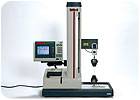Force testers measure everything from the strength of bonded joints to the toughness of tomato skins.

This digital force tester can measure how much force is needed to actuate a syringe or compress a spring. Photo courtesy Ametek Inc.
In fact, there’s more to a syringe than you might think. The plunger must move smoothly with just the right amount of resistance. If it’s too hard to push, a health care worker will have trouble measuring precise amounts of fluid. If there’s not enough resistance, the worker could easily draw too much blood or inject too much medicine.
Establishing the right feel for the motion of the plunger is the province of design engineers. It falls to the manufacturing engineer to ensure that what’s on the drawing board is actually what comes off the assembly line. And, as every manufacturing engineer knows, “stuff happens.” A batch of barrels can be out of tolerance. The piston supplier can change the rubber formulation in some subtle but significant way.
The only way to be certain that syringes perform as specified is to test them. One instrument for doing just that is the Chatillon TCD225 digital force tester from Ametek Inc. (Largo, FL). The device consists of a console, a frame with a ballscrew-driven linear motion system, and an intelligent load-sensing system that measures force with an accuracy of ±0.1 percent. Intended for use on the shop floor, the tester is lightweight and compact. It does not have to be connected to a PC.
The speed of the crosshead can be adjusted from 0.001 to 50 inches per minute. A closed-loop PID controller positions the crosshead with an accuracy of ±0.25 percent. A thumbwheel drive lets operators control the speed and position of the crosshead when operating the unit in manual mode. Mechanical limits on the front of the column prevent accidental overranging, and limit switches prevent overloads.
The tester can be outfitted with seven interchangeable load sensors, ranging from 250 grams to 200 pounds. Safeguards prevent operators from using the wrong sensor on a particular test.
The tester collects data at a rate of 1,000 samples per second. The sample rate can be configured from 1 to 1,000 hertz. Data can be displayed in graphical, tabular or statistical form, and the results can be downloaded automatically to a USB flash drive.
The instrument provides data on peak load, minimum load, break load, load at a limit, average load and relaxation rate. It also records distance measurements, including distance at minimum load, distance at break load, and creep rate.
For testing syringes, the instrument is not used on every assembly, but rather a random sample. After the syringe is loaded in a fixture, the tester pushes and pulls on the plunger, recording exactly how much force is needed to do the job. The tester might also be used to measure how much force is needed to tear off the needle.
Spring manufacturers use force testers to measure how much force is needed to compress newly made springs to set distances. This can be critical to the operation of spring-actuated assemblies, such as brakes, throttles and shock absorbers. The tester would be used to check the first few springs to come off the coiling machine whenever a new roll of steel is loaded or there’s a model changeover. Once the manufacturer is certain that the equipment is producing springs consistently, force testing can stop.
Force testers have myriad other applications in manufacturing and assembly. They measure the stretchiness of electrical cords and gauge the strength of crimped wire connections and joints bonded with adhesive. A manufacturer of military uniforms uses a force tester to measure the strength of pockets and the durability and elasticity of waistbands. In the food industry, the instruments are used to quantify the toughness of tomato skins, the crispiness of snack chips, the firmness of gelatin, and the strength of beverage cups and lids.



